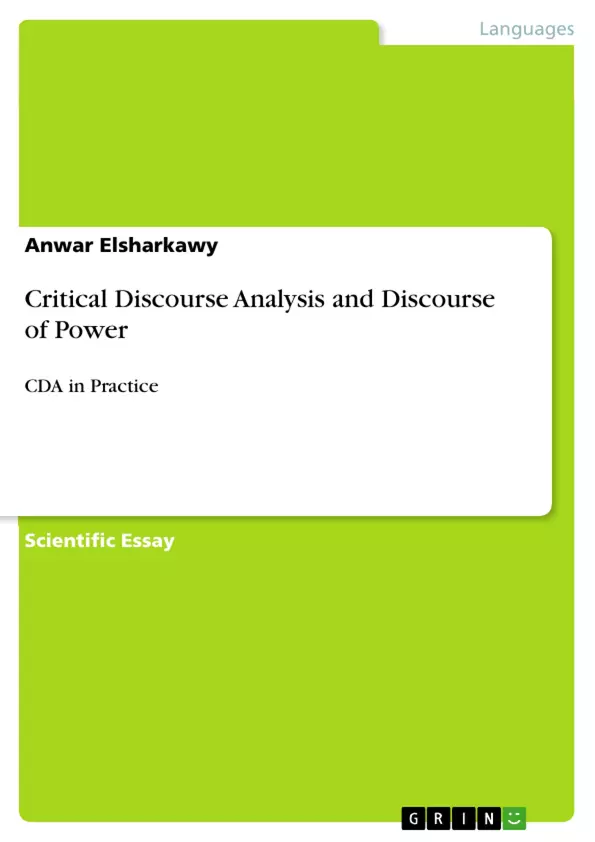The present paper has shown the practical part of CDA according to three scholars, namely they are Norman Fairclough, Ruth Wodak, and Teun van Dijk. Their approaches are somehow different in method and way of interpretation. While Fairclough is brought up on the systemic-functional model of theory and thus often concentrates on rather limited amounts of research material, Wodak turns to sociolinguistics and ethnography with an emphasis on corpus-based research and on work with different approaches with a variety of empirical data as well as background information. However, the notion that language is inherently social remains a key assumption in both approaches.
On the other hand, similarly to Fairclough, van Dijk acknowledges three different perspectives; text, discourse practice and sociocultural practice, and emphasizes on the link between textual analysis and sociocultural analysis. However, van Dijk differentiates himself from both Fairclough and Wodak in his understanding of social events or of social institutions and power relations. To van Dijk, social cognitions mediate between micro- and macro-levels of society, between discourse and action, between the individual and the group. Therefore, the focus on social cognition governs the process of analysis.
Inhaltsverzeichnis (Table of Contents)
- Introduction
- CDA as Practice
- Fairclough's Social Analysis
- Terminology and Definitions
- Methodology
- Linguistic Analysis
- Discursive Analysis
- Social Analysis
- Forms, meanings and effects
- Wodak's Approach: Discourse-Historical Analysis
- Methodology
- The Linguistic and Discursive Model in Discourse-Historical Approach
- Linguistic and Discursive Strategies
- Pragmatic Strategies
- Van Dijk's Socio-cognitive Approach
- Terminology and definitions
- Methodology
- Action
- context
- Ideology
- Power
- Conclusion
Zielsetzung und Themenschwerpunkte (Objectives and Key Themes)
This paper examines Critical Discourse Analysis (CDA) as a practical approach in the field of discourse analysis. It aims to reveal various methods for practicing CDA, leading to the development of a practical framework that can be applied to various texts. It explores the interconnectedness between discourse and society, highlighting CDA's significance as a transdisciplinary approach, particularly in the context of powerful discourse. This approach to practicing CDA is primarily based on the contributions of Norman Fairclough, Ruth Wodak, and Teun van Dijk.
- Methods and applications of CDA in practice
- Relationship between discourse and social and cultural developments
- Different approaches to CDA, including those by Fairclough, Wodak, and van Dijk
- Role of power and ideology in discourse
- Link between CDA and Political Discourse Analysis (PDA)
Zusammenfassung der Kapitel (Chapter Summaries)
The first chapter provides an introduction to CDA as a practical approach in discourse analysis, highlighting its interdisciplinary nature and focus on the relationship between discourse and society. Chapter 2 delves into the practical methods of CDA, reviewing the approaches of scholars like Fairclough, Wodak, and van Dijk and their connections to Political Discourse Analysis (PDA). Chapter 3 explores Fairclough's social analysis of discourse, defining key terminology and outlining his methodology. Chapter 4 examines Wodak's approach to discourse-historical analysis, presenting her methodology, the linguistic and discursive model, and strategies used. Finally, Chapter 5 discusses van Dijk's socio-cognitive approach to CDA, outlining his terminology, methodology, and key concepts like action, context, ideology, and power.
Schlüsselwörter (Keywords)
The key focus topics and concepts explored in this paper include Critical Discourse Analysis (CDA), discourse analysis, social and cultural developments, power relations, ideology, linguistic analysis, discourse-historical approach, socio-cognitive approach, political discourse analysis (PDA), and methodologies of CDA practitioners like Fairclough, Wodak, and van Dijk.
- Quote paper
- Dr. Anwar Elsharkawy (Author), 2012, Critical Discourse Analysis and Discourse of Power, Munich, GRIN Verlag, https://www.grin.com/document/350938



